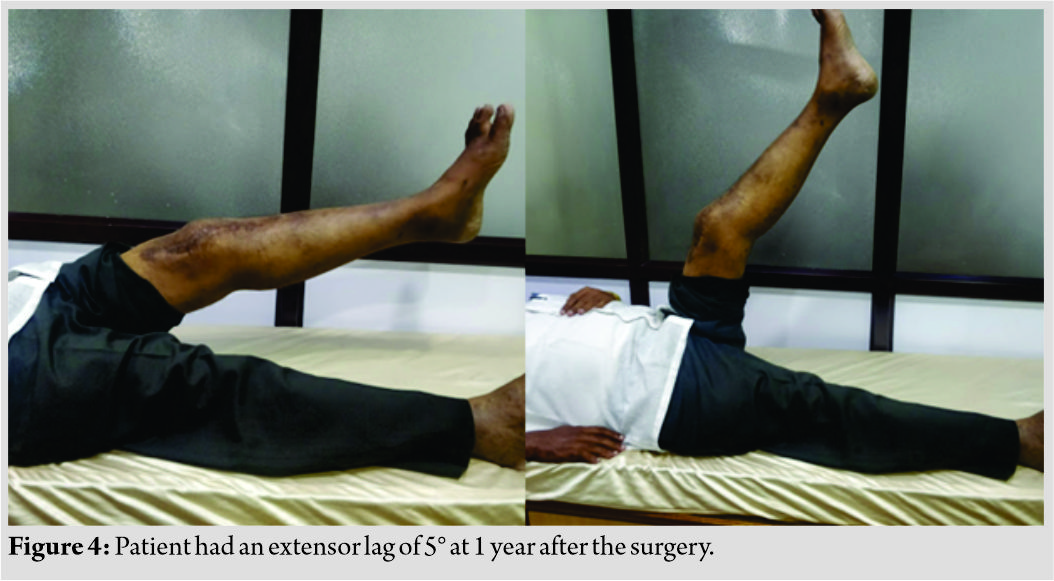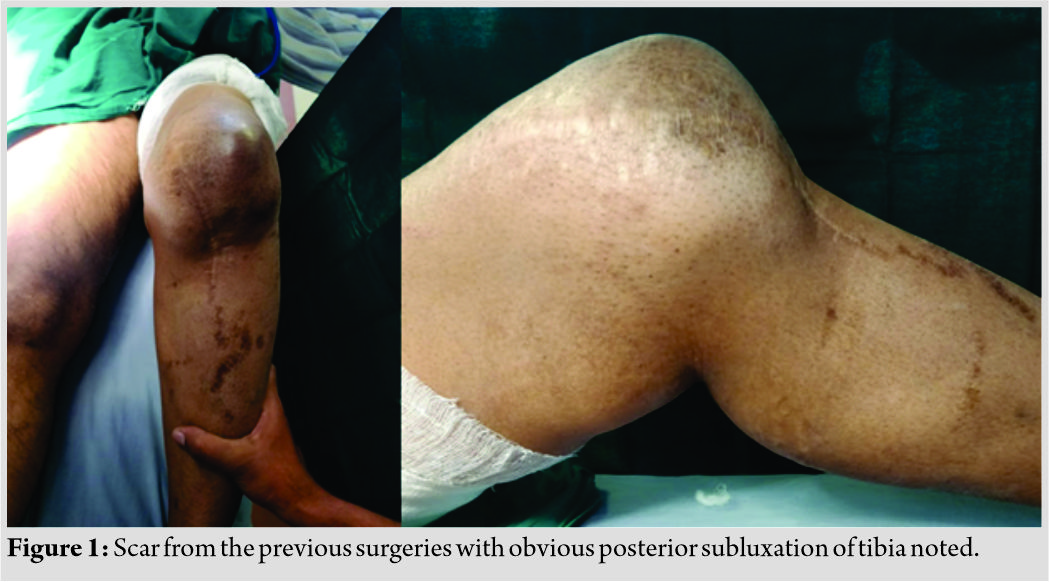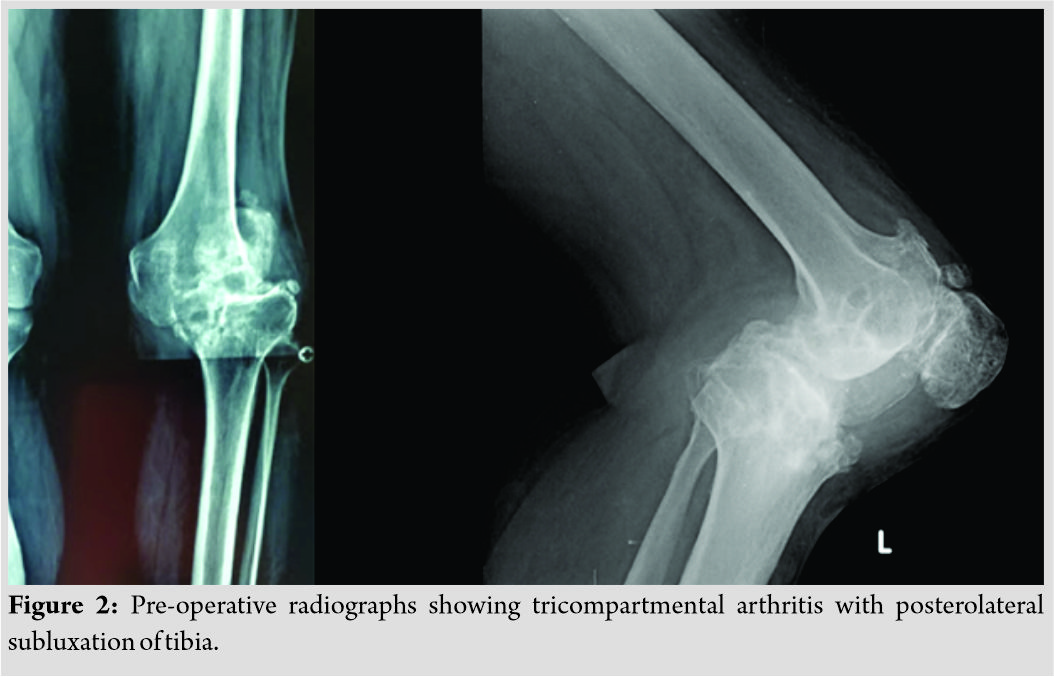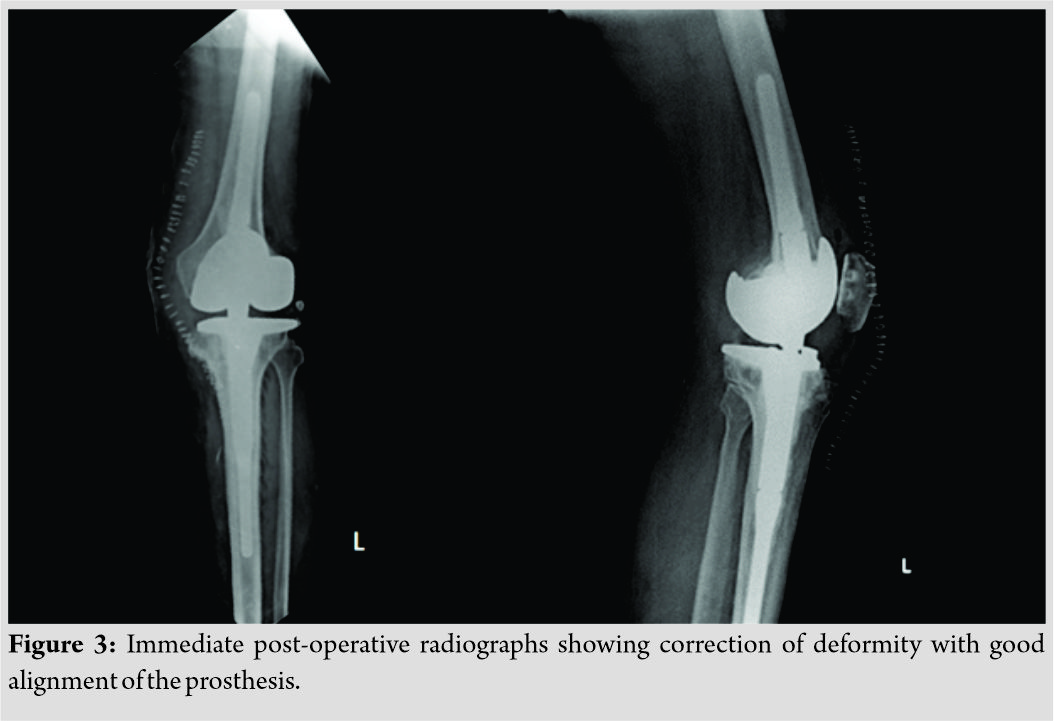[box type=”bio”] Learning Point of the Article: [/box]
A neglected knee dislocation presenting with arthritis treated in a single stage with hinged total knee prosthesis gives excellent mid-term clinical and radiological results.
Case Report | Volume 10 | Issue 6 | JOCR September 2020 | Page 68-71 | Sharath Kittanakere Ramanath1, Rahul Hemant Shah2, Ashwini Varadha Rajan3, Sandesh Patil1. DOI: 10.13107/jocr.2020.v10.i06.1880
Authors: Sharath Kittanakere Ramanath[1], Rahul Hemant Shah[2], Ashwini Varadha Rajan[3], Sandesh Patil[1]
[1]Department of Orthopaedics, Ramaiah Medical College and Hospitals, Bengaluru, Karnataka, India,
[2]Department of Orthopaedics, Bharatratna Dr. Babasaheb Ambedkar Hospital, Mumbai, Maharashtra, India,
[3]Department of Orthopaedics, Aster Hospital, Kochi, Kerala, India.
Address of Correspondence:
Dr. Rahul Hemant Shah,
Department of Orthopaedics, Bharatratna Dr. Babasaheb Ambedkar Hospital, Mumbai, Maharashtra. India.
E-mail: rahul54shah@gmail.com
Abstract
Introduction: Neglected knee dislocations are a rare entity. They present with gross degenerative changes and ligament laxity. There is no defined protocol for the treatment of arthritic knees in neglected knee dislocations.
Case Report: A 54-year-old male presented with pain and limp over his left knee after sustaining a knee dislocation 25 years back which was unsuccessfully reduced by open methods twice. Since the patient was a farmer and involved in heavy labor activities, we decided to avoid arthrodesis of his knee and help him ambulate immediately without any functional limitations. We performed a hinged total knee arthroplasty (TKA) which corrected the deformity, ligament laxity, and pain and helped him gain complete range of movements. The patient was followed-up till 30 months after the surgery with excellent clinical and radiological results.
Conclusion: A hinged TKA is a reliable technique to correct a neglected knee dislocation in a single sitting provided thorough pre-operative assessment and post-operative physiotherapy are done.
Keywords: Total knee arthroplasty, hinged prosthesis, dislocation, knee, neglected
Introduction
Knee dislocation is a rare entity [1] with neglected cases being even rarer than acute dislocations [2]. Such cases do not have a defined protocol and pose several challenges during total knee arthroplasty (TKA) such as bony deformities, soft-tissue contractures, and ligament laxity. Pre-operative planning and choosing the appropriate implant are imperative for successful surgical outcome. Here, we present a case of a 54-year-old male with a 25-year-old history of dislocated knee.
Case Report
A 54-year-old farmer had a road traffic accident 25 years back. He sustained left knee dislocation. Initial reduction by closed methods was unsuccessful. Hence, open reduction was done. The first open reduction was done immediately after the failed closed reduction attempt and the second was done 1 month after the first. The procedures were unsuccessful as complete reduction was not achieved. An above knee back slab was applied for 4 weeks which was later converted into an above knee cast for 6 weeks. The patient did not follow up with the doctor after cast removal and took treatment from a bone setter. The patient limped while walking with no complains of instability for the first 4 months after cast removal. The patient was pain free till about 15 years back.
The patient was limping with knee pain when he presented to us. He complained of instability while climbing stairs and walking briskly. Visible deformity of the knee was evident (Fig. 1). The patient was able to extend his knee completely without extensor lag. However, flexion was restricted to 80°. Radiographs revealed severe arthritis with marked posterolateral tibial subluxation (Fig. 2). Pre-operative Oxford Knee Score was 17. Skin condition around the knee was good barring the scar from previous surgeries. Doppler study showed a triphasic flow in distal arteries. The patient had ankle dorsiflexion and plantar flexion of Medical Research Council power 5/5 with intact distal sensations.
The patient was planned for the left TKA after pre-operative clinical examination and templating. All the appropriate sterile precautions were taken. Incision was made on the previous surgical incision which was curvilinear toward the medial side. Gross degenerative changes were noted over the articular surfaces of femur, tibia, and patella. Extensive lateral release was done. A 5 degree valgus cut was taken over the distal femur. Distal femur resection of 14 mm was done adjacent to the femoral attachment of medial collateral ligament. Tibial cuts were kept to as minimum as possible. Gross flexion and extension mismatch were noted. (Rotating Hinged Knee [RHK], Zimmer) implants were inserted due to multidirectional instability and to correct mismatch. Patella resurfacing was done. Tibia was brought back to its anatomical position.
Immediate post-operative radiographs showed correction of the deformity with good position of the prosthesis (Fig. 3). Skin staples were removed after 2 weeks. The patient was followed up once every 2 weeks till 3 months. He was put on a long knee brace for a period of 3 months to maintain the knee in extension and followed-up once a month thereafter. At 1 year after the surgery, the patient had an extension lag of 5° (Fig. 4). Supervised physiotherapy was continued. The patient had knee flexion up to 120° without extension lag at 30 months follow-up (Fig. 5). 
Discussion
Reduction on an emergency basis is the best treatment for dislocations. Neglected dislocations and subluxations are encountered rarely [3]. Ilizarov external fixators, Steinmann pins, arthrodesis, hinged external fixators, and TKA have been described to treat neglected knee dislocations [3, 4]. Petrie et al. reported two cases of post-traumatic knee dislocation who underwent TKA. One of the cases was a 72-year-old man who had a knee dislocation with common peroneal nerve and popliteal artery injury. The patient also sustained lateral collateral ligament avulsion which was fixed with a washer and screw. TKA was done 4 months after the dislocation. The second case was that of a 35-year-old man who was initially managed with an external fixator for 2 months following which TKA was done 4 months after removal of the fixator. They achieved 3–95° and 10–80° of flexion, respectively [4]. The duration of injury in these cases was shorter compared to ours. Hence, soft-tissue damage and instability are lesser in these cases compared to a long-standing dislocation. Arthrodesis can be considered for neglected knee dislocation [5]. However, it is best left for young individuals with gross ligamentous laxity. Although arthrodesis gives a painless joint, it compromises the functionality significantly. Vicente-Guillen et al. [2] described a case of neglected knee dislocation for a period of 50 years with limb shortening of 15 cm. They performed arthrodesis of the knee using an external fixator which gave good results. Arthrodesis could not be considered for our patient since he was 54 years old and a farmer was involved in hard labor activities. The history of knee sepsis is a relative contraindication for TKA as mentioned by Polyzois et al. [6] in their article where they performed a three staged knee arthrodesis for a 40-year history of neglected knee dislocation due to septic arthritis. Our patient gave no history of infection or discharge from the affected knee joint. This was confirmed on clinical examination and blood investigation. This made a hinged TKA the best option to correct the deformity and arthritis and gives good functional results. Long-standing knee dislocation causes gross degenerative changes and multidirectional laxity. Younger patients who present at a relatively earlier stage can be managed by joint preserving surgeries and appropriate ligament reconstruction procedures provided their joint shows no signs of arthritis [7]. This was not possible in our patient due to tricompartmental arthritis. Constrained TKA is indicated in cases of disruption of knee ligaments with severe instability [8]. Using unconstrained implants lead to dislocation, commonly in immediate post-operative period [9]. However, constrained implants have to be used with caution [10, 11]. A case reported by Cavaignac et al. [8] mentioned two episodes of intraprosthetic dislocation using constrained TKA implants. Extensor mechanism was augmented in the second revision surgery using a double hamstring graft. They emphasized the importance of having good extensor mechanism as a soft-tissue balance to prevent dislocation after the surgery. In our case, the extensor mechanism was good as assessed on pre-operative examination. Dauwe and Vandenneucker included 11 retrospective studies for primary indications to use rotating-hinged implants [12]. Majority of the indications were for osteoarthritis and rheumatoid arthritis. Other indications included collateral ligament insufficiency, distal femur or proximal tibia bone loss, hyperlaxity, hyperextension, axial deformity of more than 20°, Charcot arthropathy in patients older than 75 years, and certain oncological conditions. None of the studies mentioned the use of a rotating-hinged implant for a neglected dislocation as a primary procedure. Bohler et al. [13] followed up 50 patients for a minimum period of 5 years. They mentioned infection, periprosthetic fracture, wound dehiscence, and implant breakage as complications of RHK. None of the above complications were noted in our patient during the entire follow-up period.
Conclusion
Neglected knee dislocations presenting with arthritis are rare. They require thorough pre-operative work-up. Hinged TKA performed in these cases gives excellent results. It corrects the deformity and instability and helps to avoid multiple surgeries. Appropriate soft-tissue release and bone cuts are of paramount importance to achieve good results. Supervised post-operative physiotherapy is needed for a long duration to achieve good range of motion.
Clinical Message
Management of neglected dislocated knee requires thorough pre-operative evaluation. TKA using hinged implants is a good option to manage such cases as it gives good clinical and radiological results in a single sitting.
References
1. Meyers MH, Harvey JP. Traumatic knee dislocation of the knee joint. J Bone Joint Surg Am 1971;53:16-29.
2. Vicente-Guillen P, Figa-Mataro J, Coloma-Bellver J. Long-standing unreduced dislocation of the knee. A case report. Int Orthop 1998;22:275-6.
3. Mani KK, Raj RD, Parimal A, Ram PB. Open reduction of neglected knee dislocation: Case report of a rare injury. Malays Orthop J 2016;10:56-7.
4. Petrie RS, Trousdale RT, Cabanela ME. Total knee arthroplasty for chronic posterior knee dislocation: Report of 2 cases with technical considerations. J Arthroplasty 2000;15:380-6.
5. Matthai T, Bhowmick K, Boopalan PR, George JC. Neglected anterior dislocation of the knee with common peroneal palsy. Case Rep Orthop 2015;2015:174965.
6. Polyzois VD, Grivas TB, Stamatis ED, Vasiliades E, Gliatis I, Stavlas P. Management of knee dislocation because of posttraumatic septic arthritis neglected for 40 years. J Trauma Acute Care Surg 2008;64:E21-3.
7. Polyzois VD, Stathopoulos IP, Benetos IS, Pneumaticos SG. A two-stage procedure for the treatment of a neglected posterolateral knee dislocation: Gradual reduction with an Ilizarov external fixator followed by arthroscopic anterior and posterior cruciate ligament reconstruction. Knee 2016;23:181-4.
8. Cavaignac E, Tricoire JL, Pailhé R, Murgier J, Reina N, Chiron P, et al. Recurring intraprosthetic dislocation of rotating-hinge total knee prosthesis. Effect of implant design on intrinsic stability. Orthop Traumatol Surg Res 2014;100:835-7.
9. Chen HC, Chiu FY. Chronic knee dislocation treated with arthroplasty. Inj Extra 2007;38:258-61.
10. Pour AE, Parvizi J, Slenker N, Purtill JJ, Sharkey PF. Rotating hinged total knee replacement: Use with caution. J Bone Joint Surg Am 2007;89:1735-41.
11. Springer BD, Sim FH, Hanssen AD, Lewallen DG. The modular segmental kinematic rotating hinge for nonneoplastic limb salvage. Clin Orthop Relat Res 2004;421:181-7.
12. Dauwe J, Vandenneucker H. Indications for primary rotating-hinge total knee arthroplasty. Is there consensus? Acta Orthop Belg 2018;84:245-50.
13. Böhler C, Kolbitsch P, Schuh R, Lass R, Kubista B, Giurea A. Midterm results of a new rotating hinge knee implant: A 5-year follow-up. Biomed Res Int 2017;2017:7532745.
 |
 |
 |
 |
| Dr. Sharath Kittanakere Ramanath | Dr. Rahul Hemant Shah | Dr. Ashwini Varadha Rajan | Dr. Sandesh Patil |
| How to Cite This Article: Ramanath SK, Shah RH, Rajan AV, Patil S. Hinged Total Knee Replacement for an Arthritic Knee Following a Neglected Knee Dislocation: A Case Report. Journal of Orthopaedic Case Reports 2020 September;10(6): 68-71. |
[Full Text HTML] [Full Text PDF] [XML]
[rate_this_page]
Dear Reader, We are very excited about New Features in JOCR. Please do let us know what you think by Clicking on the Sliding “Feedback Form” button on the <<< left of the page or sending a mail to us at editor.jocr@gmail.com








